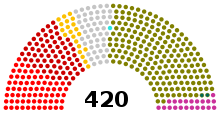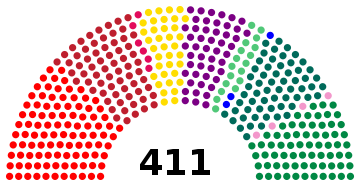1947 Hungarian parliamentary election
| |||||||||||||||||||||||||||||||||||||||||||||||||||||||||||||||||||||||
All 411 seats in the National Assembly 206 seats needed for a majority | |||||||||||||||||||||||||||||||||||||||||||||||||||||||||||||||||||||||
This lists parties that won seats. See the complete results below.
| |||||||||||||||||||||||||||||||||||||||||||||||||||||||||||||||||||||||
 |
|---|
Parliamentary elections, which later became known as the "blue-ballot" elections, were held in Hungary on 31 August 1947.[1] The Hungarian Communist Party, which had lost the previous election, consolidated its power in the interim using salami tactics. Communist-led political intrigues had deprived their opposition of its democratically won mandate from 1945, as numerous prominent anti-Communists were removed from office on charges of conspiracy. These conspiracies reached a climax in late May 1947, when the Hungarian Communist Party deposed the democratically elected prime minister Ferenc Nagy in a coup d'état, removing one of the strongest opponents to their rule and crippling the opposition. This weakening of the opposition, combined with a revised electoral law, led to further Communist gains. This would be the last remotely competitive election held in Hungary until 1990.
Background


The Independent Smallholders' Party had won a large majority in the previous elections in 1945, but the Soviet-dominated Allied Control Commission had forced it into a coalition government which gave the Hungarian Communist Party key positions including the Ministry of Interior. Communist intrigues had then forced dozens of potent political rivals out of the ruling coalition on the grounds of ostensible reaction. In early 1947, the Communists accused large sections of the Smallholders' Party of complicity in the "Hungarian Fraternal Community" conspiracy, using it as an excuse to expel over 40 MPs and deprive the FKGP of its legally won parliamentary majority.[3] In the process, Soviet troops kidnapped Béla Kovács—general secretary of the Smallholders' Party—on 25 February and deported him to the USSR, where he would be imprisoned for eight years. This had culminated in the ouster of the democratically elected Prime Minister Ferenc Nagy, who was blackmailed into exile in May 1947 under threat of being "revealed" as part of the plot.
Earlier, the National Assembly had passed a law that barred statements hostile to the "democratic order" or harmed Hungary's international reputation. Increasingly, this law was used to legally gag the opposition. The Communists also began pushing leaders of the non-Communist parties out of the government after branding them as "reactionaries" or "anti-democratic." In some cases, this was a prelude to their arrest.[4]
The expelled deputies had formed new parties like the Hungarian Freedom Party (SZP) under Dezső Sulyok outside the governing coalition, but in July 1947 the now Communist-dominated Parliament dissolved the Freedom Party under a law intended to deprive its electorate of the vote. Sulyok went into exile soon after, and the anti-Communist opposition became divided between several parties. From this position of strength, the Communists began to organize new elections, confident that they could win them.
Preparations began for the elections in the summer of 1947, with Soviet troops still in the country. The Communists intended to exploit the situation that arose as a result of the disarray of their main rival, the Independent Smallholders Party, to gain a clear majority in the legislature.[5] Their campaign's central theme was the party's national character; during the coalition years, the Communists had presented themselves as the champion of national interests and as heirs to the nation's tradition.[6] During these preparations, two events clearly indicated the politicisation of economic issues and the economic significance of political decisions. Following pressure from Moscow, on 10 July the Hungarian government announced its abstention from the conference that was discussing the Marshall Plan for Europe's postwar reconstruction. Slightly earlier, a State Planning Office was created, the three-year plan as urged by the Communists in the previous year was enacted, and on 1 August its implementation began.[5]
A new electoral law (Lex Sulyok) was also introduced, which excluded about 466,000 people (almost a tenth of the electorate) on grounds of membership of the pre-war fascist party.
Parties and leaders
In order to divide the opposition, the Communist-controlled election commission amended the electoral laws to allow for the registration of more political parties than in 1945. Most of the new parties—primarily the Democratic People's Party, Independence Party and Independent Democratic Party—were composed of former members of the Smallholders' Party.
Results
Despite rigging the elections (more than 50,000 fraudulent votes were cast for them)[8][9] the Communists only managed to increase their vote share to 22% and failed to attain an absolute majority even with the other parties of the Left Wing Bloc. Although the emasculated and demoralised Smallholders only received 15% of the vote, other non-leftist parties did well; the Democratic People's Party of István Barankovics came second (keeping alive a real opposition and showing the strength of popular commitment to pluralism)[8] and Zoltán Pfeiffer's Independence Party was not far behind the Social Democrats.[10] Parties outside the governing coalition won a total of 40% of the vote, despite Rákosi's pre-election predictions that they would only win 15%.[11] The Smallholders' Party and other non-leftists — the DNP, MFP and FMDP — received a total of 2.5 million votes overall (around 51%), roughly the same vote share that the Smallholders had received two years earlier. The combined non-Communist and non-Left Bloc parties still wielded a narrow majority of seats in the legislature. In addition, the Communists inserted a clause into the electoral law stating that the four government parties could divide over 80% of seats between them on the national list if the coalition won more than 60% of the vote. The governing parties had only barely exceeded this limit under the influence of the blue slips. This new rule was especially harmful to the Democratic People’s Party, which won the second-largest number of votes but received the fourth-largest number of mandates.[12]
 | ||||||||
|---|---|---|---|---|---|---|---|---|
| Party | Votes | % | Seats | |||||
| Constituency | National List | Total | +/– | |||||
| Hungarian Communist Party | 1,111,001 | 22.25 | 79 | 21 | 100 | +30 | ||
| Democratic People's Party | 824,259 | 16.50 | 58 | 2 | 60 | New | ||
| Independent Smallholders Party | 766,000 | 15.34 | 54 | 14 | 68 | –177 | ||
| Social Democratic Party of Hungary | 742,171 | 14.86 | 53 | 14 | 67 | –2 | ||
| Hungarian Independence Party | 670,751 | 13.43 | 47 | 2 | 49 | New | ||
| National Peasant Party | 413,409 | 8.28 | 29 | 7 | 36 | +13 | ||
| Independent Hungarian Democratic Party | 262,109 | 5.25 | 18 | 0 | 18 | New | ||
| Hungarian Radical Party | 85,535 | 1.71 | 6 | 0 | 6 | +6 | ||
| Christian Women's League | 69,363 | 1.39 | 4 | 0 | 4 | New | ||
| Civic Democratic Party | 49,740 | 1.00 | 3 | 0 | 3 | +1 | ||
| Total | 4,994,338 | 100.00 | 351 | 60 | 411 | +2 | ||
| Valid votes | 4,994,338 | 99.36 | ||||||
| Invalid/blank votes | 31,950 | 0.64 | ||||||
| Total votes | 5,026,288 | 100.00 | ||||||
| Source: Nohlen & Stöver | ||||||||
Aftermath
Although the Left Bloc failed to win a parliamentary majority, the Smallholders' left wing thwarted a coalition initiative from the two main opposition parties, and the previous government coalition remained in office. The remaining non-collaborationist Smallholders made a final attempt to take over the party at its congress in September, but the fellow-travelling leaders thwarted this.[13] The manageable Smallholder Lajos Dinnyés remained Prime Minister and dutiful fellow travelers from other parties were named to the cabinet for the sake of preserving the parliamentary facade. Cominform came into being just days after the new Dinnyés government took office. In December 1948 Dinnyés was ultimately replaced by the leader of the Smallholders' left wing: the openly pro-Communist István Dobi, who had been a secret card-carrying member of the Communist Party for years.[14]
Still, the opposition was large enough so that only extra-parliamentary means could eliminate it. On 4 November, the Communist-controlled election commission accused the Hungarian Independence Party of fraud and summarily nullified all its parliamentary mandates—leaving over 700,000 voters unrepresented—and its leader Zoltán Pfeiffer fled into exile soon after.[15] The vacant seats were not filled, leaving the Communists and their allies with an increased proportion. The remaining effective opposition parties steadily buckled under Communist pressure over the course of the following year, with their members either arrested, deprived of their mandates, or fleeing into exile.[16] Communist persecution radically changed the composition of Parliament prior to the next elections in 1949. By the dissolution of Parliament, more than 120 of the remaining 364 MPs were members not elected in 1947, a rate of turnover unmatched in Hungarian political history.[17] Intimidation, targeting of the increasingly submissive democratic parties (and absorption of the Social Democrats), nationalisation, collectivisation and other measures soon rendered the 1945–47 period a short democratic interlude, with the Communists soon wielding exclusive power.[18]
References
- ^ Dieter Nohlen & Philip Stöver (2010) Elections in Europe: A Data Handbook, p. 899 ISBN 978-3-8329-5609-7
- ^ "A hatalmi dualizmus időszaka".
- ^ Part 2: Communist take-over, 1946-1949 The Institute for the History of the 1956 Revolution.
- ^ Burant, Stephen R. Hungary: A Country Study p48
- ^ a b László Kontler (2002) A History of Hungary, Palgrave Macmillan, p. 401 ISBN 1-4039-0316-6
- ^ Martin Mevius (2005) Agents of Moscow, Oxford University Press, p. 190 ISBN 0-19-927461-4
- ^ “An Attempt at a New, Democratic Start.” Hungary 1944-1953, Lesson 1. The Institute for the History of the 1956 Revolution, [1]
- ^ a b László Borhi (2004) Hungary in the Cold War, 1945–1956, Central European University Press, p. 127 ISBN 963-9241-80-6
- ^ Some estimates go as high as 200,000; this marred the election's integrity, in addition to doubts about the count, pre-election intimidation, the Communists' encouragement of the Smallholders' breakup, and the fleeing into exile, arrest and deportation of many non-communist party leaders. Jason Wittenberg (2006) Crucibles of Political Loyalty, Cambridge University Press, pp. 56–57 ISBN 0-521-84912-8
- ^ Kontler, pp. 401–02
- ^ Part 2: Communist take-over, 1946-1949 The Institute for the History of the 1956 Revolution.
- ^ A hatalmi dualizmus időszaka
- ^ Hungary 1944-1953: Chronology The Institute for the History of the 1956 Revolution.
- ^ Borhi, László. Hungary in the Cold War, 1945-1956. Central European University Press (2004), p. 77 ISBN 963-9241-80-6
- ^ Hungary 1944-1953 Part 2: Communist take-over, 1946–1949. The Institute for the History of the 1956 Revolution.
- ^ Hungary 1944-1953: Glossary. The Institute for the History of the 1956 Revolution.
- ^ Hungary 1944-1953 Part 3: Hungary's period of classical Stalinism, 1949–1953. The Institute for the History of the 1956 Revolution.
- ^ Kontler, p. 402
